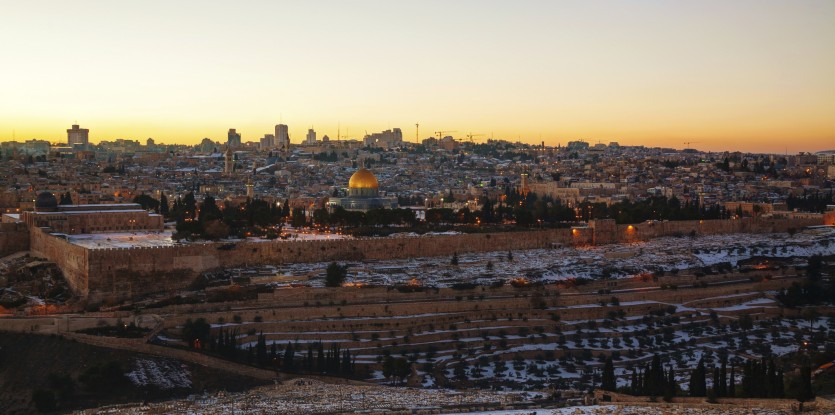And G-d revealed Himself to Abram, and said: “To your descendants I will give this land.”
Genesis 13:7
And [G-d] said to him: “I am G-d, who has taken you out of Ur Casdim to give you this land as an inheritance.”
Genesis 15:7
In the year 2488 from creation (1272 bce), Joshua marched the armies of Israel, 600,000 strong, across the Jordan River to conquer the land that G-d had promised to Abraham.
In a series of battles that spanned seven years, the Israelites defeated the armies of the thirty-one kings of Canaan. Joshua then divided the land among the twelve tribes of Israel, and each tribe proceeded to settle its allotted share. But pockets of resistance remained, and the process of conquering and settling the Holy Land was completed only four hundred years later by King David, who defeated the Philistines and conquered the city of Jerusalem from the Jebusites.
With David’s son, Solomon, began four centuries of Jewish sovereignty over the Holy Land—a period which overlapped the First Temple Era, when the first Beit HaMikdash (Holy Temple) stood in Jerusalem. But in 3205 (555 bce), the northern kingdom of Israel[1] was conquered by Shalmaneser, king of Assyria, and the ten tribes living there were exiled. A century later, the southern kingdom of Judea was conquered by Nebuchadnezzar, king of Babylonia, and it, too, came under foreign rule. In 3338 (422 bce) Nebuchadnezzar destroyed the Holy Temple in Jerusalem, and virtually all of the Jewish people were exiled from their land.
The Return
The Jewish people returned to the Holy Land after a 70-year exile in Babylonia. Led by Ezra and Nechemiah, they rebuilt the Holy Temple and began a second period of national life in their homeland. The Second Temple Era lasted 420 years, until the destruction of Second Temple by the Romans in 69 ce and the subsequent dispersion of Israel to the four corners of the globe.
The First and Second Temple periods differed in many areas—spiritually, halachically (in matters pertaining to Torah law), materially, culturally and politically. One of these differences was that under Joshua the people of Israel conquered the Land and ultimately established full Jewish sovereignty over its territory, while the Jews under Ezra came as settlers with a franchise from the Persian emperors under whose dominion the Holy Land lay. Indeed, for much of the Second Temple Era the Holy Land was under the political hegemony of foreign kings—the Persians, the Greeks, and following a brief 70-year period of independence following the Hasmonean revolt, the Romans.
This suggests a superiority of the First Temple Era. Indeed, in many respects, the Second Temple Era was inferior to that of the First Temple.[2] However, a most basic law pertaining to the halachic status of the Holy Land implies the very opposite: that the settlement of the land under Ezra was of greater and more lasting significance to our connection to the Holy Land than its conquest under Joshua.
The Land of Israel is referred to by the Torah (as it is in many of the earth’s languages) as a “holy” land. In essence, this reflects its special place in G-d’s creation and in His providence over His world[3]; in practice, the holiness of the Land of Israel is expressed in the fact that many of the mitzvot (divine commandments) of the Torah relate specifically to its territory and cannot be fulfilled anywhere else. And while the essential holiness of the Land of Israel is intrinsic and exists at all times and under all conditions, its halachic holiness is a factor of its possession by the Jewish people. Only those parts of the Holy Land that actually came under Jewish possession are obligated in the mitzvot that relate to the Land. In other words, by taking possession of the Land of Israel the Jewish people also “sanctified” it, establishing the boundaries within which these special mitzvot can be fulfilled.
There were two such “sanctifications”: the sanctification achieved by Joshua’s conquest of the land, and the sanctification effected by its settlement under Ezra. Torah law distinguishes between the two: Joshua’s sanctification of the land was temporary, and when the people of Israel were exiled to Babylonia the land reverted to its halachically “non-holy” status. But the effect of Ezra’s sanctification was permanent, remaining in force also after the destruction of the Second Temple and the exile of Israel. To this day, the halachic boundaries for the mitzvot of the land are the boundaries of the Jewish settlement in the Second Temple Era, not those of the First Temple Era.
Maimonides explains: since the first sanctification was a achieved by conquest, it endured only as long as the conquest endured. The second sanctification, however, was not achieved by the establishment of political sovereignty, so it is not dependent upon it; thus, the fact that the land was taken from us did not diminish its holiness.[4]
Gift or Inheritance
The Rogatchover (famed scholar and analyst of Torah law, Rabbi Yosef Rosen, 1858-1936) relates these two “sanctifications” to the two verses quoted at the beginning of this essay. In the 13th chapter of Genesis, we first read of G-d’s promise to Abraham, “To your descendants I will give this land.” Later, in chapter 15, we read of the covenant that G-d made with Abraham in which He reiterated this promise; here, the word “inheritance” first appears as a description of Israel’s relationship with the land.
According to Torah law, a gift might be temporary, but never an inheritance, which, by definition, is interminable. (Thus the law states that a person can instruct that his field should be given to someone for twenty years, following which it should be transferred to someone else; but if he says “My son should inherit the field for twenty years,” his statement has no legal validity, since “a gift can be terminated, while an inheritance cannot be terminated.”[5]) The verse in chapter 13, in which G-d promises to give the land to Abraham’s descendants, refers to the conquest by Joshua, whose effect was reversible. In chapter 15, G-d is referring to the acquisition of the land by Ezra which, like an inheritance, is everlasting.[6]
The terms “gift” and “inheritance” also reflect the nature of these two acquisitions of the Land. In a gift, the recipient’s connection with the given thing is imposed upon him by the will and rights of the giver; thus the giver also determines the extent and duration of the gift. The right over an inheritance, on the other hand, is something intrinsic to the nature of the inheritor: the inherited thing is his not because it has been given to him, but by virtue of who and what he is. Thus, no outside factor can limit the inheritance
Joshua’s sanctification of the Land was achieved by an external dynamic—the conquest; so—like the gift—it was contingent upon the extent and duration of the vector that imposed it. When the conquest ceased, so did its effect on the halachic status of the Land.
In Ezra’s time, the Jewish people sanctified the Land not by conquering it, but by settling it. Thus they asserted their intrinsic bond with the Land—a bond that is not contingent upon military might or political rule. They came as heirs, whose relationship to the land derives from within—from who and what they are—rather than from what has been imposed by a superior force. So the sanctity they effected in the Land was—like the inheritance—immune to the influence of external forces, and did not cease when the armies of Rome drove them from their homeland.
Land as Life
The purpose of creation, say our sages, is that “G-d desired a dwelling in the physical world.”[7] Namely, that man should sanctify the material existence and develop it into a “home” for G-d—a place where His quintessential being is manifestly present and expressed. Thus, the endeavor to conquer and settle the Land, and thereby transform it into a “Holy Land,” can be said to represent the overall objective of life on earth.
Just as there were two primary modes of sanctification of the Land—the “conquest” mode of the First Temple Era and the “settlement” mode of the Second Temple Era—so, too, are there two modes of sanctification in the macrocosmic endeavor of life, corresponding to the two primary states of man: that of the tzaddik (perfectly righteous person) and the baal teshuvah (“returnee” or penitent).
In the narrow sense of these terms, the tzaddik is a person who is utterly and perfectly good, without a single misdeed to his behavior or negative trait to his character, while the baal teshuvah is one who has succumbed to evil but has returned to a righteous life. In the broader sense, the tzaddik is one whose spiritual life is characterized by harmony and tranquillity, while the baal teshuvah is one who engages in a perpetual struggle with the negative within him and in his world.
Both the tzaddik and the baal teshuvah participate in the development and sanctification of the material world. The tzaddik, however, affects the world from without. Aloof from the cares and trappings of material life, the tzaddik radiates from his goodness upon it, vanquishing the forces of darkness with his superlative light. But because this is a transformation from above, it is sustainable for only as long as the tzaddik maintains his influence upon it. For the world itself has not changed; it has only been overwhelmed by a superior force.
The baal teshuvah, on the other hand, transforms the world from within. He is no stranger to material life, no aloof observer of its contortions and corruptions; when he sanctifies the mundane, it is a sanctity coming from within, from the world’s inner potential to house its Creator. Lacking outside sources of holiness, the baal teshuvah delves into the nature of the material to uncover therein the light implicit within the darkness, the holiness implicit within the mundanity. And because it represents a transformation from within, the divine home constructed by the baal teshuvah is self-sufficient and immutable.
In the First Temple Era, we were a nation of tzaddikim. Born at Sinai and formed in the spiritual cocoon of a generation of desert life, we had no experience with the Land, with the material dimension of creation. So we conquered it, overwhelming it with our superior force, with the spirit’s natural preeminence over the material. But because this was a conquest imposed from above, the holiness of the Land could be maintained only as long as the conquering element remained in force. When we turned away from G-d, when we lost our spiritual edge, we also lost the Land, and the Land lost its holiness.
Returning from Babylonia, we entered the Land as a nation of baalei teshuvah (returnees)—a nation who had succumbed to evil only to best it in its own arena, a nation now intimate with the material world and wise to its wiles. This time, we settled the Land. Our aim was not to conquer it and assert our dominance over it, but to develop it from within, to unleash its own potential as a divine abode.
This time, the sanctity we evoked in it was intrinsic and enduring. So even when our sins and failings subsequently banished us from our land, the Land remained holy, for the most powerful armies and the most potent evils could not efface the quintessential holiness we had effected in our ancestral heritage.
Based on the Rebbe’s talks, Av 20 and 30, 5738 (August 23 and September 3, 1978), and Sukkot 5724 (1963)[8].
Adapted from the teachings of the Lubavitcher Rebbe by Yanki Tauber
[1]. Following King Solomon’s death, ten of the twelve tribes broke away to form the kingdom of Israel in the north, while the descendants of Solomon continued to rule the southern kingdom of Judea.
[2]. Most significantly in that the era of prophecy came to a close in the first years of the Second Temple Era. See also Ezra 3:12; Talmud, Yoma 21b.
[3]. Cf. Deuteronomy 11:12; Midrash Tanchuma, Re’eh 8; Talmud, Ketubot 110b; et al.
[4]. Mishneh Torah, Laws of the Holy Temple, 6:16; Laws of Terumot and Maaserot, 1:1-9. Of course, the Jews under Joshua also settled the land, in addition to conquering it; but because G-d had commanded them to conquer the land (cf. Numbers 33:52-55; Deuteronomy 3:18; Joshua ch. 1; Talmud, Sotah 44b), this determined that the mode of their acquisition of the Land, and the nature of their relationship with it, be that of “conquest.” In Ezra’s time, the divine command was to return to the land and settle it, not to conquer it (cf. Jeremiah 29:10, 40:10), determining that the mode of acquisition be “settlement.”
It is important to note that the differences between the “first acquisition” by Joshua and the “second acquisition” by Ezra relate only to the “holiness” of the Land as it pertains to the observance of the special mitzvot associated with it, but not to the Jewish ownership of the Land of Israel, which is constant and irreversible. Regarding our ownership of the Land, the Torah states that “on that day G-d established a covenant with Abraham, to say: ‘To your descendants I have given this land, from the River of Egypt to the great river, the Euphrates’” (Genesis 15:18). Here the Torah uses the past tense, “I have given” (as opposed to the future-tense “I will give” employed by the verses which relate to the “holiness” of the land) in order to emphasize that the entire territory of the Promised Land has already been given to Abraham by the creator and master of the world. The land that the Jewish people conquered under Joshua and settled under Ezra was already their property (see Jerusalem Talmud, Challah 2:1; Rashi on Genesis 1:1).
This ownership of the Land, granted by G-d to all generations of Israel, is not negotiable, and cannot be relinquished by treaties or agreements. No individual or government has the right to give away our eternal heritage or to relinquish control over those parts of it which G-d has placed in our hands amidst great miracles.
[5]. Talmud, Bava Batra 129b.
[6]. Tzafnat Paane’ach on Genesis 15:7. Cf. Jerusalem Talmud, Bava Batra 8:2.
[7]. Midrash Tanchuma, Nasso 16; Tanya, ch. 36.
[8]. Likkutei Sichot, vol. XV, pp. 100-109.








I might be mistaken,but when you mention chapter 13 it should be 12?
Thank you, i highly enjoyed it,
Danja